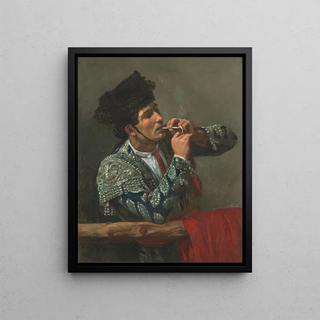Art print | After the corrida - Mary Cassatt


View from behind

Frame (optional)
In the world of art, some works transcend their era to become timeless witnesses to the human condition. "Après la corrida" by Mary Cassatt is a perfect example. This canvas, imbued with delicacy and sensitivity, captures a fleeting moment where the contemplation of human emotions blends with the beauty of everyday life. Cassatt, although American, was able to absorb French Impressionist influences to create a unique visual language, where light and color intertwine with finesse. The piece invites us to immerse ourselves in a moment of life, where the tranquility of a moment after the excitement of a corrida touches us deeply.
Style and uniqueness of the work
Mary Cassatt's style is distinguished by her ability to combine intimacy and social observation. In "Après la corrida," she depicts a scene that, at first glance, might seem mundane, but reveals an unsuspected depth. The composition highlights two female figures, one of whom appears lost in thought, while the other, observing, embodies a form of silent complicity. The color palette chosen by the artist evokes a soothing softness, where pastel shades blend with brighter touches, creating a subtle contrast that draws the eye. Cassatt uses fluid brushstrokes, almost Impressionist, which bring life to the canvas while maintaining clarity in the forms. This marriage of technique and emotion makes this work a masterpiece that speaks to the soul.
The artist and her influence
Mary Cassatt, an emblematic figure of the Impressionist movement, managed to establish herself in an artistic environment largely dominated by men. Born in 1844, she developed a style that is her own, mainly focusing on women and children, subjects often neglected by her contemporaries. Influenced by artists such as Degas, Cassatt brought a new perspective on domestic life and interpersonal relationships. Her commitment to representing women in all their complexity paved the way for future generations of artists. By integrating elements of French culture while preserving her American identity, she was able to create

Matte finish

View from behind

Frame (optional)
In the world of art, some works transcend their era to become timeless witnesses to the human condition. "Après la corrida" by Mary Cassatt is a perfect example. This canvas, imbued with delicacy and sensitivity, captures a fleeting moment where the contemplation of human emotions blends with the beauty of everyday life. Cassatt, although American, was able to absorb French Impressionist influences to create a unique visual language, where light and color intertwine with finesse. The piece invites us to immerse ourselves in a moment of life, where the tranquility of a moment after the excitement of a corrida touches us deeply.
Style and uniqueness of the work
Mary Cassatt's style is distinguished by her ability to combine intimacy and social observation. In "Après la corrida," she depicts a scene that, at first glance, might seem mundane, but reveals an unsuspected depth. The composition highlights two female figures, one of whom appears lost in thought, while the other, observing, embodies a form of silent complicity. The color palette chosen by the artist evokes a soothing softness, where pastel shades blend with brighter touches, creating a subtle contrast that draws the eye. Cassatt uses fluid brushstrokes, almost Impressionist, which bring life to the canvas while maintaining clarity in the forms. This marriage of technique and emotion makes this work a masterpiece that speaks to the soul.
The artist and her influence
Mary Cassatt, an emblematic figure of the Impressionist movement, managed to establish herself in an artistic environment largely dominated by men. Born in 1844, she developed a style that is her own, mainly focusing on women and children, subjects often neglected by her contemporaries. Influenced by artists such as Degas, Cassatt brought a new perspective on domestic life and interpersonal relationships. Her commitment to representing women in all their complexity paved the way for future generations of artists. By integrating elements of French culture while preserving her American identity, she was able to create






